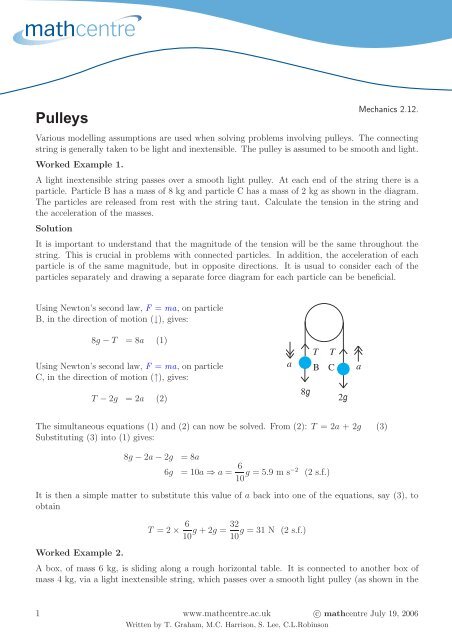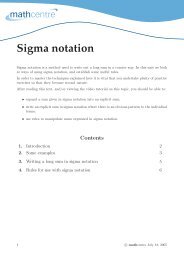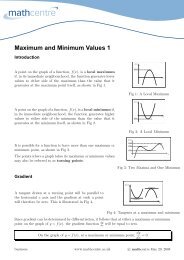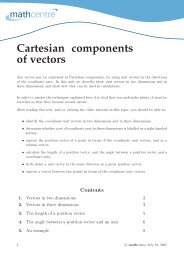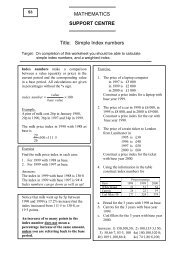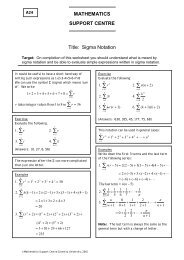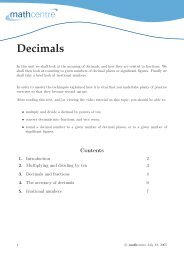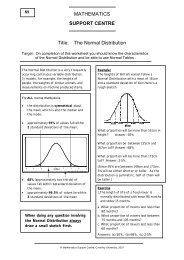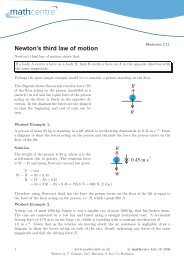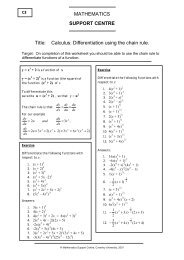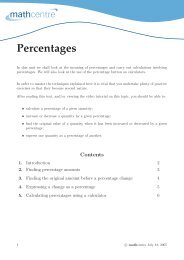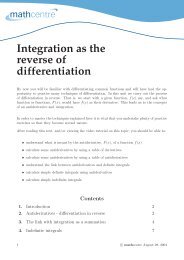Pulleys
Pulleys
Pulleys
You also want an ePaper? Increase the reach of your titles
YUMPU automatically turns print PDFs into web optimized ePapers that Google loves.
<strong>Pulleys</strong><br />
Mechanics 2.12.<br />
Various modelling assumptions are used when solving problems involving pulleys. The connecting<br />
string is generally taken to be light and inextensible. The pulley is assumed to be smooth and light.<br />
Worked Example 1.<br />
A light inextensible string passes over a smooth light pulley. At each end of the string there is a<br />
particle. Particle B has a mass of 8 kg and particle C has a mass of 2 kg as shown in the diagram.<br />
The particles are released from rest with the string taut. Calculate the tension in the string and<br />
the acceleration of the masses.<br />
Solution<br />
It is important to understand that the magnitude of the tension will be the same throughout the<br />
string. This is crucial in problems with connected particles. In addition, the acceleration of each<br />
particle is of the same magnitude, but in opposite directions. It is usual to consider each of the<br />
particles separately and drawing a separate force diagram for each particle can be beneficial.<br />
Using Newton’s second law, F = ma, on particle<br />
B, in the direction of motion (↓), gives:<br />
8g − T = 8a (1)<br />
Using Newton’s second law, F = ma, on particle<br />
C, in the direction of motion (↑), gives:<br />
T − 2g = 2a (2)<br />
a<br />
8g<br />
T T<br />
B C<br />
2g<br />
a<br />
The simultaneous equations (1) and (2) can now be solved. From (2): T = 2a + 2g (3)<br />
Substituting (3) into (1) gives:<br />
8g − 2a − 2g = 8a<br />
6g = 10a ⇒ a = 6<br />
10 g = 5.9 m s−2 (2 s.f.)<br />
It is then a simple matter to substitute this value of a back into one of the equations, say (3), to<br />
obtain<br />
Worked Example 2.<br />
T = 2 × 6 10<br />
32<br />
g + 2g = g = 31 N (2 s.f.)<br />
10<br />
A box, of mass 6 kg, is sliding along a rough horizontal table. It is connected to another box of<br />
mass 4 kg, via a light inextensible string, which passes over a smooth light pulley (as shown in the<br />
1 www.mathcentre.ac.uk c○ mathcentre July 19, 2006<br />
Written by T. Graham, M.C. Harrison, S. Lee, C.L.Robinson
diagram). Given that the coefficient of sliding friction between the table and the box is 0.3, what<br />
is the acceleration of each particle and what is the tension in the string?<br />
Solution<br />
Firstly consider the box on the table. The magnitude of the normal reaction, R, is equal to the<br />
magnitude of the weight of the box, 6g. As the box is sliding:<br />
Friction = F r = F MAX = µR = 0.3 × 6g = 1.8g<br />
Applying Newton’s second law, F = ma, on this<br />
box in the direction of motion (→), gives:<br />
T − F r = 6a<br />
T − 9 g = 6a (1)<br />
5<br />
Applying Newton’s second law, F = ma, to the<br />
hanging box in the direction of motion (↓), gives:<br />
Fr<br />
a<br />
R<br />
6g<br />
T<br />
4g<br />
T<br />
a<br />
4g − T = 4a (2)<br />
Rearranging (1) gives: T = 6a + 9g (3) 5<br />
Substituting into (2) gives: 4g − 6a − 9 11<br />
g = 4a ⇒ 10a = g ⇒ a = 11g<br />
= 2.2 m 5 5 50 s−2 (2 s.f.)<br />
Substituting this back into one of the equations, say (3) gives:<br />
. T = 6 × 11g<br />
+ 9g = 78 g = 31 N (2 s.f.)<br />
50 5 25<br />
Exercises<br />
1. A light, inextensible string passes over a smooth light pulley. At each end of the string there is<br />
a particle, as in Worked Example 1. Particle B has a mass of 10 kg and particle C has a mass<br />
of 9 kg. The particles are released from rest with the string taut. Calculate the acceleration<br />
of the masses and the tension in the string.<br />
2. A light, inextensible string passes over a smooth light pulley. At each end of the string there<br />
is a particle, as in Worked Example 1. Particle B has a mass of 11 kg and particle C has a<br />
mass of x kg. Given the acceleration of the masses is 2.2 m s −2 and particle B is accelerating<br />
downwards, calculate the tension in the string and the mass, x, of particle C.<br />
3. A box, of mass 1.2 kg, is sliding along a rough horizontal table. It is connected, via a light<br />
inextensible string passing over a smooth light pulley, to another box of mass 1.2 kg, as in<br />
Worked Example 2. Given the coefficient of friction between the table and the box is 0.44,<br />
what is the acceleration of each particle and what is the tension in the string?<br />
4. A car, of mass 450 kg, is on a slope which is inclined at 45 ◦ to the horizontal. It is attached<br />
via a light inextensible string, which passes over a smooth light pulley, to a box of mass 400<br />
kg, which is accelerating downwards (similar to Worked Example 2, only with an inclined<br />
slope). Given a resistive force of 450 N acts on the car, what is its acceleration and what is<br />
the tension in the string?<br />
Answers (All to 2 s.f.)<br />
1. a = 0.52 m s −2 , T = 93 N 2. T = 84 N, x = 7.0 kg 3. a = 2.7 m s −2 , T = 8.5 N,<br />
4. a = 0.41 m s −2 , T = 3800 N.<br />
2 www.mathcentre.ac.uk c○ mathcentre July 19, 2006<br />
Written by T. Graham, M.C. Harrison, S. Lee, C.L.Robinson


